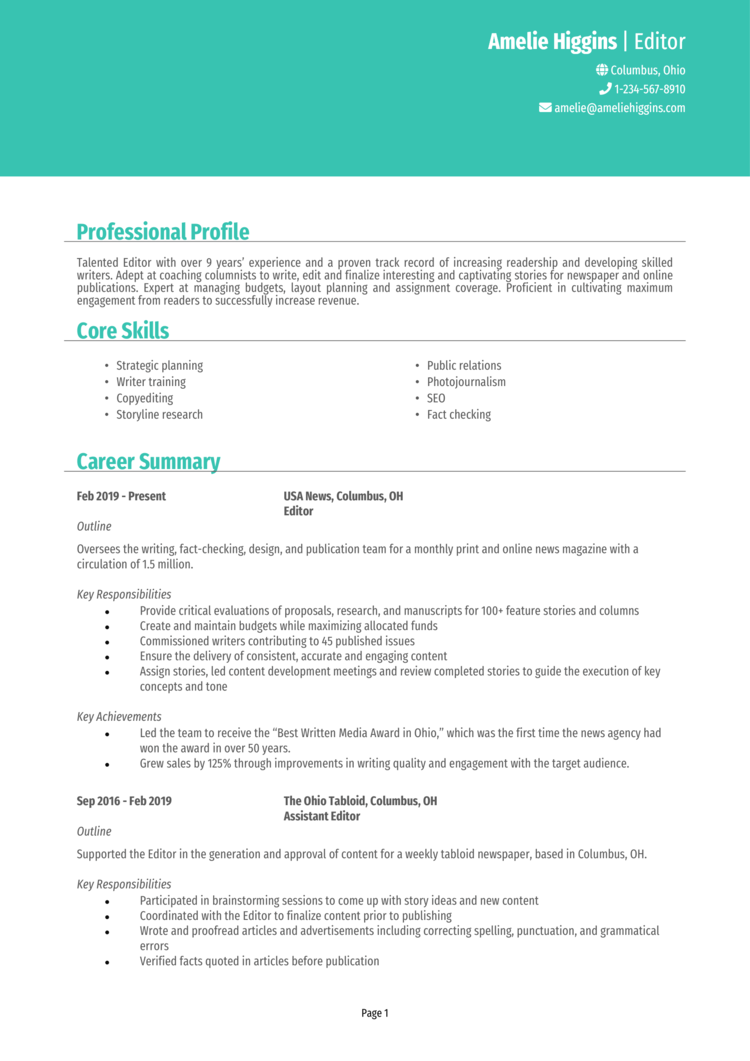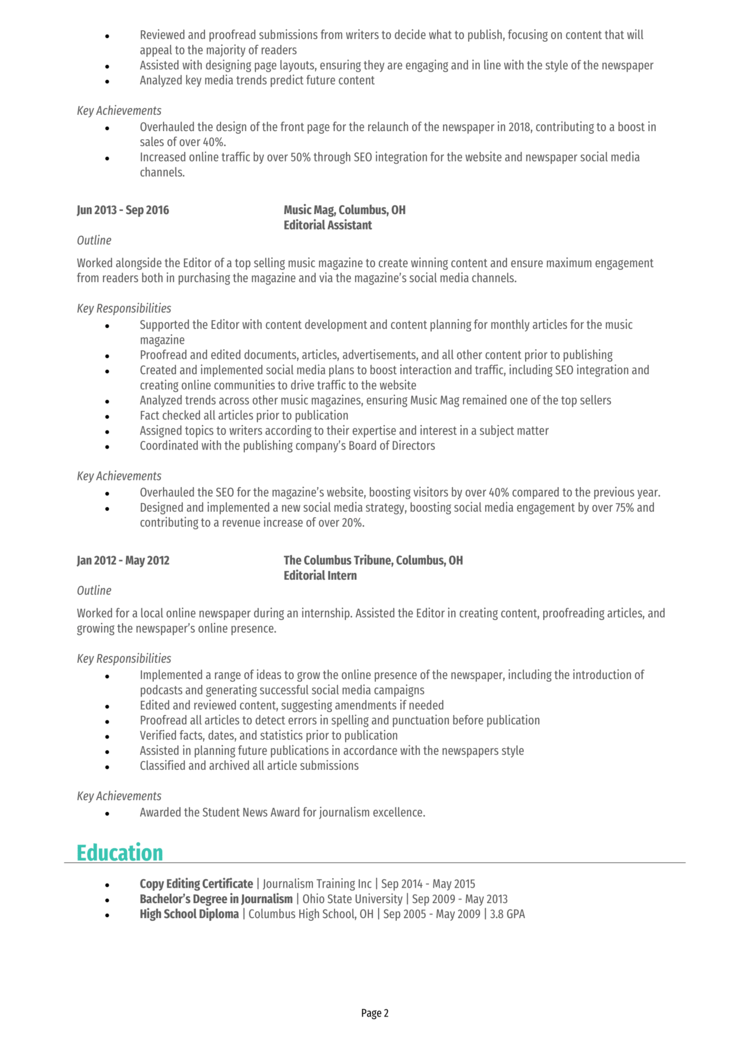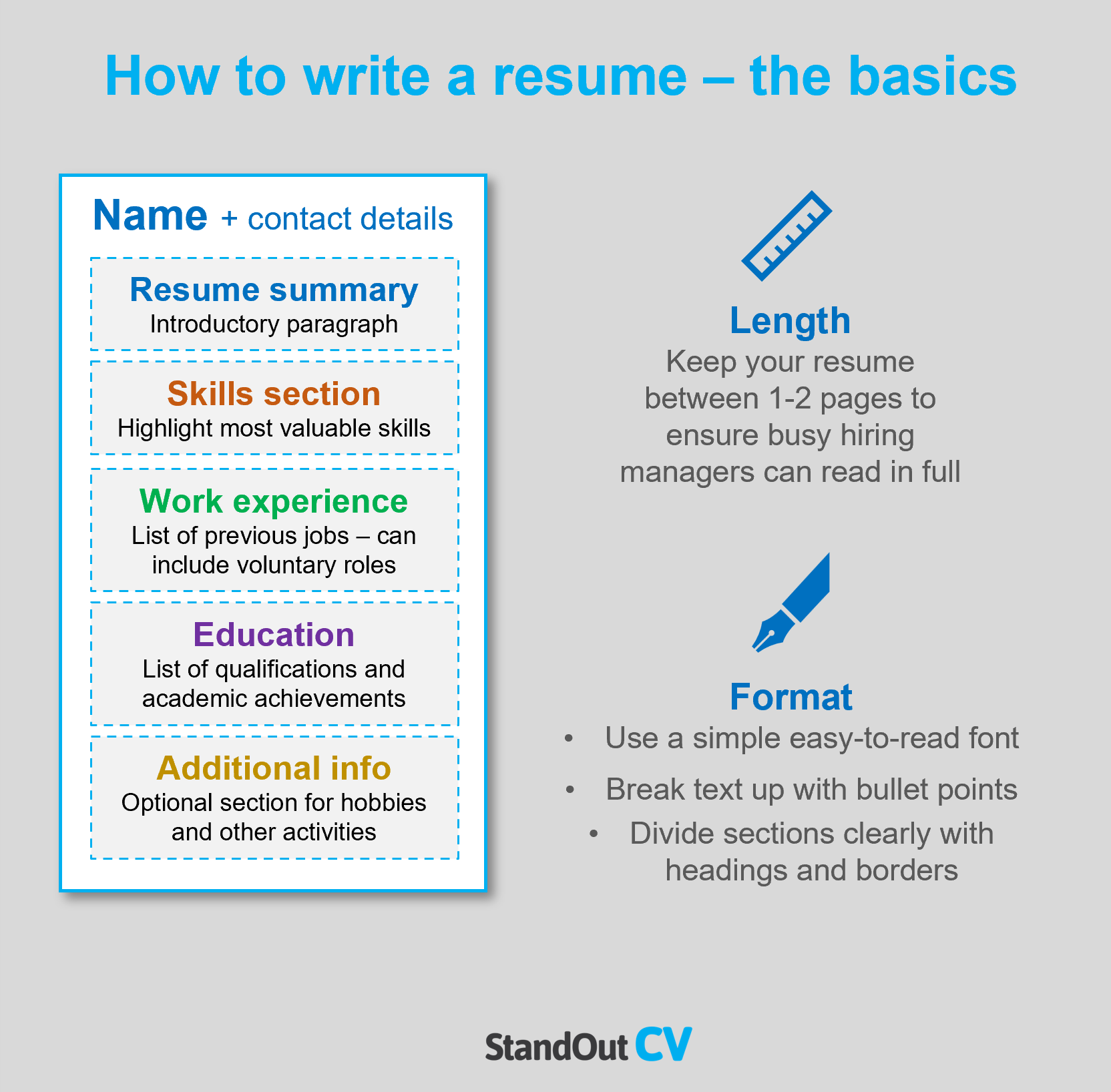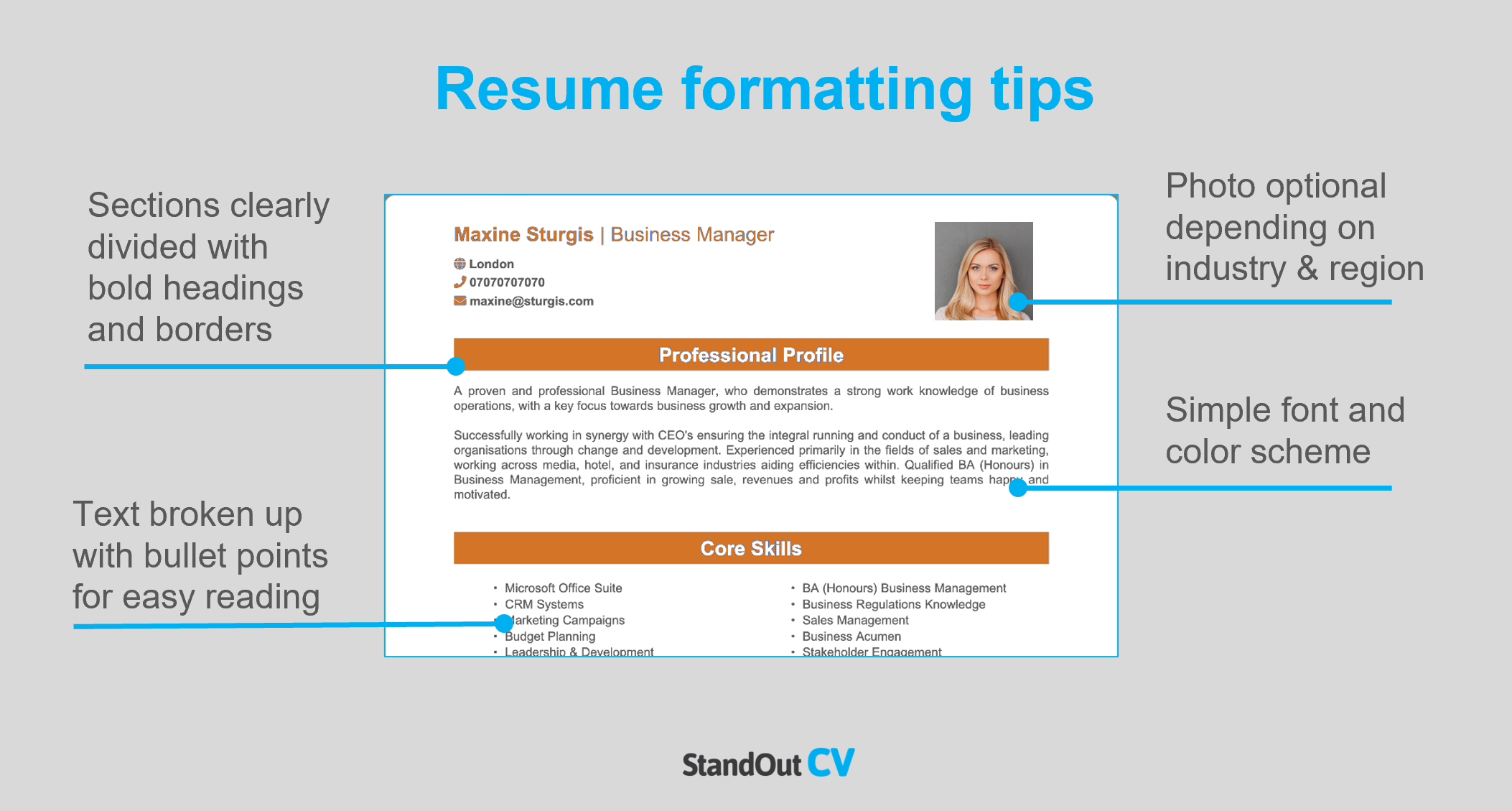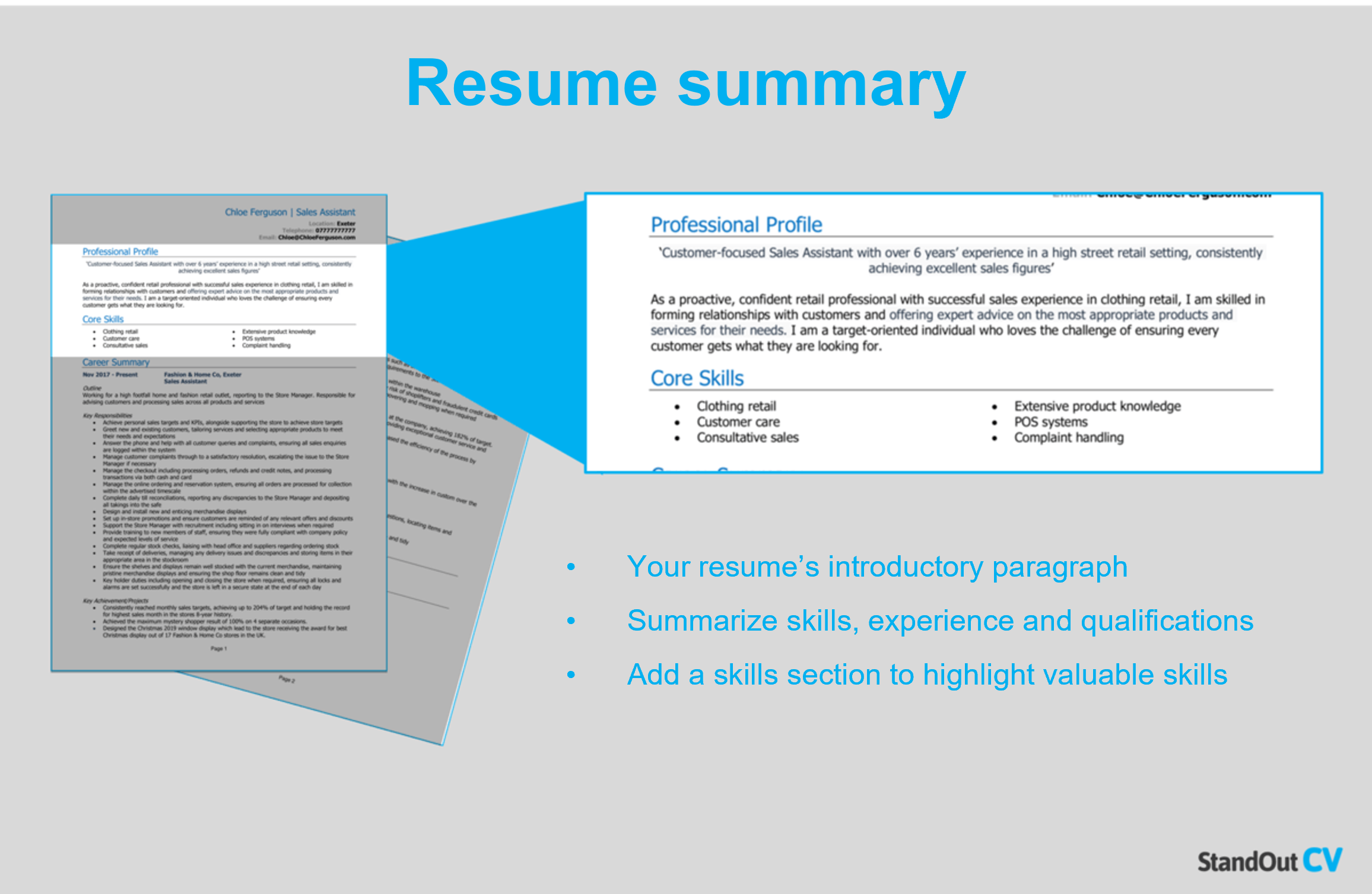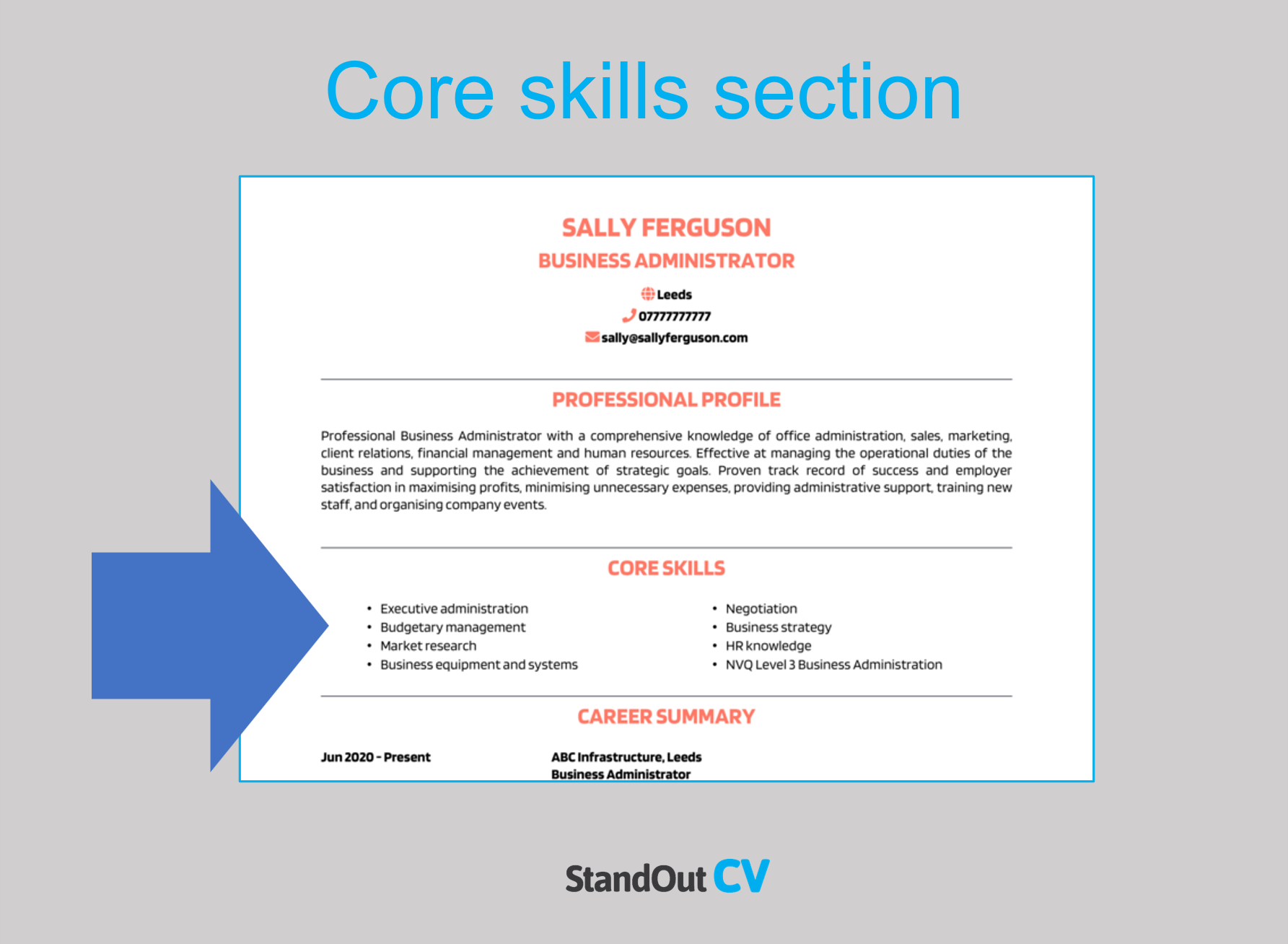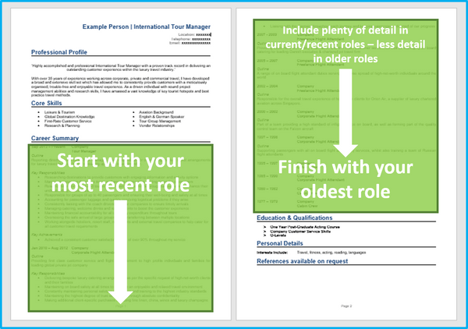You’ve mastered the literary word, and you’re ready to spend your days perfecting the content of others, but you need to get over that first hurdle, writing your own resume.
Good editing jobs are increasingly hard to come by, so you need to craft an application that gives you a competitive edge.
To help you do this, we’ve created a resume writing guide, as well as an editor resume example to inspire your own.
Contents
|
Editor Resume Example
The above Editor resume example gives you a good steer on how a Editor resume should look and read.
The information is presented professionally, and the content is well structured to ensure that time-strapped recruiters and managers can spot the important skills and knowledge quickly.
Refer to this example as you write your own resume.

Editor resume layout and format
If you want to get noticed in the job market, you have to pay attention to the format and layout of your resume.
Essentially your resume needs to look highly polished, and provide hiring managers with an easy reading experience.
Use these resume formatting tips to get a head start on this.
Tips for resume formatting
- Length: Think that submitting a 10 page resume will impress recruiters? Unfortunately it won’t… Even if you’ve got tons of experience to brag about, recruiters don’t have time to read essays, so keep it brief – around 2 pages is the sweet spot.
- Font and text: Complex fonts are a readers’ worst nightmare and will leave recruiters struggling to understand your message. Use a clear simple lean font in a color that stands out against the page, and break your text up with bullet points to make the content easily digestible.
- Design & structure: Hiring managers should be able to skim through your resume easily and pinpoint the information they want quickly. To help them do this, organize the page into clear sections with bold headings and dividing borders. The design should be clutter-free and professional-looking, with a calm color scheme.
- Photos and images: You are not obliged to add a photo to your resume in the USA, but it can be a nice way of adding some life to the document.
Quick tip: Formatting a resume to look professional can be difficult and time-consuming. If you want to create an attractive resume quickly, try our quick-and-easy Resume Builder and use one of their eye-catching resume templates.
Resume layout
Add the following sections when you write your resume.
- Name and contact details – Add to the very top of your resume to introduce yourself and make it super-easy for recruiters to get in touch.
- Resume summary – Reel hiring managers in with an “elevator pitch” style paragraph which sums up your suitability for the job.
- Skills section – A short and sharp list of your most important skills, that can be quickly skim-read.
- Work experience – List your previous jobs (from newest to oldest) detailing the skills learnt and applied in each.
- Education – List your qualifications and professional training.
- Additional info – If it helps your application, you can add an extra section for things like hobbies and interests.
Now, here’s what to include in each of these sections in your resume.
Resume Contact Details
Add your name and contact details to the very top of your resume, making it easy for recruiters to get in touch
- Name and profession title
- Cell phone number – or another number you can answer quickly
- Location – Add your local area such as San Diego or New York – not your full address as that will take up too much space.
- Email address – Use your name or close variation – no nicknames from high school.
You can add a link to your LinkedIn profile if you have one – you do not need to include personal details like date of birth or marital status.
Editor Resume Summary
Your resume summary is like an elevator pitch. It’s your chance to sell yourself to employers within a short space of time.
Achieve this by summarizing your skills and expertise, whilst highlighting your abilities that closely match the jobs you are aiming for.
Top tips for creating an effective resume summary:
- Keep it brief: Your summary is intended to be a high-level introduction to hook readers’ attention, so keep it brief (4-7 lines) – save the details for later in your resume.
- Tailor it: Ensure your profile makes an impact by matching it closely to the requirements of the job description, copying as many key terms as possible.
- Avoid cliches: Recruiters always see cringey cliches like “hardworking guru who works well in a team or individually” – they don’t mean much to anyone, so focus your summary on tangible skills and experience.
Example resume summary for Editor
Talented Editor with over 9 years’ experience and a proven track record of increasing readership and developing skilled writers. Adept at coaching columnists to write, edit and finalize interesting and captivating stories for newspaper and online publications. Expert at managing budgets, layout planning and assignment coverage. Proficient in cultivating maximum engagement from readers to successfully increase revenue.
What to include in your Editor resume summary?
- Summary of your experience: Provide an overview of the type of work you have done in the past and the impact you have made at previous employers.
- Relevant skills: Skills that are highly relevant to Editor work should be made prominent throughout your summary.
- Important qualifications: Any qualifications that are important to the Editor jobs you are applying for, should be mentioned in the summary.
Quick tip: Choose from hundreds of pre-written summaries across all industries, and add one to your resume with one click in our quick-and-easy Resume Builder. All written by our recruitment experts and easily tailored to suit your unique skillset.
Core skills section
Underneath your summary, write a core skills section to make your most relevant skills jump off the page at readers.
It should be made up of 2-3 columns of bullet points of your relevant skills.
Before you do this, look over the job description and make a list of any specific skills, specialisms or knowledge required.
Then, make sure to use your findings in your list. This will paint you as the perfect match for the role.
Best skills for your Editor resume
Strategic planning – writing and following a plan to reach a specific marketing goal such as increasing revenue and profits, achieving greater visibility or discouraging competitors.
Public relations – managing and disseminating information from the organization to the public in order to influence their perception of the company and its products or services.
Copyediting – checking written material (copy) for mistakes, inconsistencies, and repetition, to ensure it is polished for publication.
SEO – optimizing a website’s technical configuration, content relevance and link popularity so its pages are easily findable, more relevant and popular towards user search queries, and ranked higher by search engines
Storyline research – researching appropriate topics to create compelling and engaging marketing material directed at the target audience.
Quick tip: Our quick-and-easy Resume Builder contains thousands of in-demand skills for every profession that can be added to your resume in seconds – saving you time and greatly improving your chances of landing job interviews.

Resume work experience section
Now that you’ve reeled recruiters in with your awesome summary, it’s time to delve into your work experience.
Here you’ll list your previous jobs (starting with your most recent and working backward) and showcase how you apply your skills in the workplace.
Provide lots of detail in recent jobs, and less in older roles.
If you have no relevant paid experience, you can include voluntary work and placements – but if you have lots of experience, you can leave out some of the really old jobs.
Structuring your job descriptions
You probably do a lot in your job, so its vital to break all of that information down into a good structure.
Structure your jobs as follows to make it easy for recruiters to skim through and pinpoint the essential info.
Job outline
Begin each job with a short summary of who the organization is, where you sit within it, and what the main goal of your position is.
Key responsibilities
List your notable responsibilities in short sharp bullet points to demonstrate your input and how you contributed to the organization’s success.
Highlight the skills that are most important to the roles you are applying for.
Key achievements
Show employers the value you can bring to them by adding a few achievements to your jobs.
Whether you’ve saved the company money or improved an internal process, let recruiters know
Add some numbers to give readers a real scale of the impact, e.g. “reduced call wait time by 10%”
Example job for Editor resume
Outline
Oversees the writing, fact-checking, design, and publication team for a monthly print and online news magazine with a circulation of 1.5 million.
Key Responsibilities
- Provide critical evaluations of proposals, research, and manuscripts for 100+ feature stories and columns
- Create and maintain budgets while maximizing allocated funds
- Commissioned writers contributing to 45 published issues
- Ensure the delivery of consistent, accurate and engaging content
Quick tip: Create impressive job descriptions easily in our quick-and-easy Resume Builder by adding pre-written job phrases for every industry and career stage.
Education resume section
Nearing the end of your resume, your education/qualifications section should be added.
In a well-structured list, add all of your qualifications and certifications that qualify you to perform a typical Editor role.
If you have plenty of work experience, keep this section brief – if not, add lots of detail to make up for your lack of experience.
Additional info for your resume
Any other info that didn’t fall into any of the previous sections can be added here.
If you have hobbies that are related to your profession or any awards or publications – add them here.

Writing your Editor resume
Following the steps in this guide will help you to create a winning Editor resume and bag lots of interviews.
If you want some more help through the process, try our quick-and-easy Resume Builder for expert guidance and tons of pre-written resume content.
Good luck with your job search!
